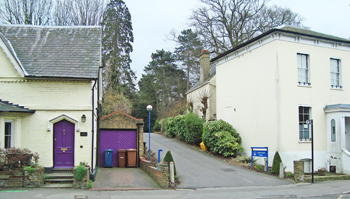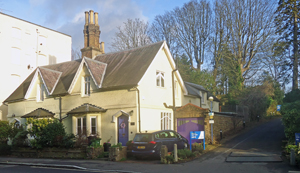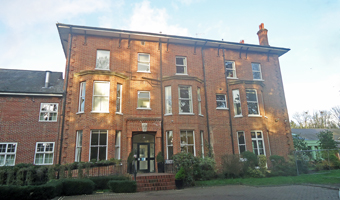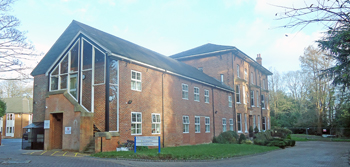Medical character:
Nursing home (mental)
Essentially a private nursing home for the treatment of patients suffering from neuroses and mild psychoses, it was the earliest of its kind. Bowden House was a 'therapeutic community', involving full participation of the nursing and even domestic staff. The 'new psychology' was very new and the majority of the medical profession was skeptical about its use.
The nursing home was located in The Hermitage, a mansion which stood in 6 acres of grounds by Julian Lane. When Dr Crichton-Miller purchased the nearby Bowden House School (originally built in 1820 as Sudbury Hill House) for use as his family home, he renamed his clinic in The Hermitage 'Bowden House'.
On admission, as well as receiving psychological treatment, each patient was given a physical examination, including biological and pathological tests. Occasionally a patient was shown to have concurrent organic problems as well as 'nerves'.
There was no official limit as to how long patients could stay, but rehabilitation was the aim of treatment - to enable the patient to develop more independence and a better adjusted attitude to life in the community. For 'nervous cases', Dr Crichton-Miller experimented with hypnotism.
In 1929 the Bowden House School building was sold to Harrow School, whereupon it became the School's Sanatorium.
The nursing home closed during WW2 (1939-1945).
In July 1948 it was disclaimed from the NHS and remained a private institution with 14 beds. Dr Crichton-Miller continued to work there until 1952.
In 1954 the nursing home, now known as Bowden House Clinic, had 19 beds and was under the management of the Bowden House Nursing Association Ltd.
In 1965, following extension, there were 47 beds.
In 1974 Lord Longford opened a new wing. The bed complement was increased to 65.
By the early 1980s the Clinic was experiencing financial difficulties and, in February 1983, was approached by an American company which was interested in taking it over. However, the Directors felt that it would be more appropriate if the Clinic was associated with a British charitable trust. They contacted the Governors of St Andrew's Hospital, an independent 'not-for-profit' charitable trust in Northampton. The Governors agreed and, on 23rd June 1983, took over administration of the Clinic. It became a short-term psychiatric facility, renamed St Andrew's at Harrow-Bowden House.
On the ground floor of the building were the main reception area, the Board Room, the kitchen and main dining room (also a small separate dining room), various lounges, a gymnasium, group therapy rooms and an occupational therapy/art room.
Patients were accommodated on both floors of the 2-story house. Part of the ground floor and the first floor formed Byron Ward. This had 30 beds for acute psychiatric male and female patients requiring treatment for alcohol or drug detoxification, eating disorders, depression or a psychotic disorder. Byron Ward occasionally housed patients who had been sectioned under the Mental Health Act, 1983. The ground floor also contained 3 high dependency observation rooms behind the nurses' station. The remainder of the first floor contained the Arthur Jones Unit, a Psychiatric Intensive Care Unit with 16 beds for male patients liable to be sectioned.
The Governors of St Andrews decided that the building needed to be modernised and also extended. In the autumn of 1986 work began on a new wing, which would provide an extra 20 beds. Once the wing had been completed, patients would be transferred there while work was carried out on the existing building. The work, however, took longer than expected and the first patients were only transferred to the new wing in January 1989.
By 1990 the Clinic could offer diagnostic assessment, treatment, rehabilitation and continuing care for those with acute psychiatric illness, stress and anxiety problems, alcohol problems, eating disorders, marital problems, including the elderly mentally infirm.
In 2001 it had 55 beds.
In 2007 the Governors of St Andrew's Hospital agreed to lease the nursing home to Cygnet Health Care Ltd for five years. The Clinic then became managed as a joint venture between St Andrew's Hospital, Northampton, and Cygnet Health Care Ltd.
Present status (March 2009)
In 2009 the Clinic became the Cygnet Hospital, with the words 'Bowden House' removed from the title.
UPDATE: December 2018
In 2015 Cygnet Health Care Ltd bought the freehold to the property and, in 2016, received planning permission to build an extension. The new wing would contain 10 beds for men with Autistic Spectrum Disorder, as well as offices and therapy and activity rooms.
Currently the Hospital consists of Byron Ward with 20 beds for men and women needing acute psychiatric in-patients care, the Springs Unit with 16 beds providing low secure accommodation, the Springs Wing with 10 beds for patients needing specialist rehabilitation and the newly completed Springs Centre, with 14 beds (4 of which are for emergency access for patients in crisis) for men with autistic spectrum disorder and other mental health difficulties or learning disabilities.

The driveway to the Hospital off London Road.
(Photograph obtained in March 2009)
N.B. Photographs obtained in December 2018

The two cottages immediately to the north of the driveway are now known as The Little House and The Hermitage. They are locally listed.

Bowden House, which was originally called The Hermitage, is also locally listed. It has been much extended over the years.

The Springs Wing has been added to the western side of Bowden House.
(Author unstated) 1974 Bowden House Clinic. British Medical Journal 2 (6th July), 54.
Bennet EA 1959 Obituary. H. Crichton-Miller. British Medical Journal 1 (5114), 116-117.
Bennet EA 1962 Hugh Crichton-Miller. British Medical Journal 1 (17th March), 774.
Cormack W 1967 Annual Report of the Medical Officer of Health. London Borough of Harrow, 89.
Foss A, Trick K 1989 St. Andrew's Hospital, Northampton: The First 150 Years (1838-1988). Cambridge, Granta Editions.
Higgins J 1988 The Business of Medicine: Private Health Care in Britain. Basingstoke, Macmillan Education.
Odlum D (undated) Chapter 40 'Bowden House, Harrow, for the Treatment of Neuroses and Mild Psychoses'. In: The Expanding Field of Mental Health in England and Wales, 50 Years of Progress, 1918-1968. Unpublished document MS 7913/42 filed at the Wellcome Library.
Richards G 2011 Psychology, Religion, and the Nature of the Soul: A Historical Entanglement. New York, Springer.
Thomas C 1947 Annual Report of the Medical Officer of Health. Urban District of Harrow, 12.
https://blackcablondon.net
https://collage.cityoflondon.gov.uk
www.british-history.ac.uk
www.cygnethealth.co.uk (1)
www.cygnethealth.co.uk (2)
www.cygnethealth.co.uk (3)
www.harrow.gov.uk (1)
www.harrow.gov.uk (2)
www.harrowfieldsgardens.btck.co.uk
www.tangramarchitects.co.uk
Return to home page